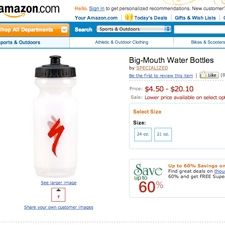Mike Sinyard's letter to retailers this week regarding Amazon's Price Check App is escalating an industry-wide conversation and examination of the interaction between brick-and-mortar stores and the many alternate retailing channels popping up online.
Sinyard, the founder and president of Specialized Bicycle Components, warned his dealers about the new app and urged them to consider their loyalty to brands whose products are available through Amazon. He named several of his company's competitors who he said participated in Amazon's price checking program.
Representatives from some of those brands, however, were quick to note that they don't sell directly to Amazon and aren't a part of any program; it's their dealers, authorized or not, who sell via Amazon's Seller Central program.
Louis Garneau and Sidi, for example, are two of the brands Sinyard cited in his letter. Neither sells directly to Amazon, although products from both companies are available on Amazon. A very small number of Specialized-branded products are available on Amazon, as well, apparently from non-authorized sources. Specialized does not sell to Amazon directly.
Cateye, another brand Sinyard mentioned, does sell to Amazon and asks that the site maintain its suggested retail prices. However, there is a glut of discounted Cateye products on Amazon.com that originated with the company's former distributors, the company told BRAIN on Thursday. Cateye went dealer direct last summer and is trying to clean up the discounted products from Amazon and other sites before the riding season hits. (See related story, Cateye cleaning up discounters)
Easton-Bell, another brand Sinyard called out, does sell "a limited assortment" of products to Amazon directly, a company representative said.
Sinyard also mentioned Shimano and Pearl Izumi. Representatives from those companies did not respond to requests for comment.
Splitting hairs?
At first glance, it may seem irrelevant how the products got on the Amazon website. So long as they are, they are a thorn in the side of some retailers. But Sinyard's letter and the resulting discussion is about long-term strategy and philosophy for the independent bicycle retailer segment of the industry. And from that perspective there are at least two key differences between a brand selling directly to Amazon and one that appears on the site via its dealers.
First, when Amazon stocks and sells products directly, the online giant can set the retail prices, run specials and offer to match or beat the prices of online or brick-and-mortar competitors. But Amazon can't set prices on products being sold through Seller Central. That's both good and bad. In Cateye's case, unauthorized retailers are selling products at such a deep discount that even Amazon would like to see them shut down. But in many cases the retailers using Seller Central are bound by minimum pricing agreements with their vendors. Sidi, for example, does not allow its stores to sell current-model-year shoes below MSRP without prior approval, in stores or online, said Al Budris, the president of Sidi America. Authorized Sidi dealers are free to discount past-year models, however. Louis Garneau also holds its dealers to its MSRP policies when they are selling online, Garneau's Pierre Perron told BRAIN. So in those cases, the Seller Central sellers help maintain higher prices than if the brand sold directly to Amazon. Budris said that's why Sidi does not sell to Amazon directly, despite requests.
Second, selling through Amazon helps make ends meet for many specialty retailers—including, other companies' reps like to point out, some large Specialized dealers. As the retail landscape evolves at a punishing pace, many dealers are exploring new ways to serve their customers and remain profitable; Amazon offers an attractive alternative for some.
"Dealers are using Amazon to help promote their own website and products," said Garneau's Perron. "The online business is much bigger than the bike industry. It's something we can't control but we need to learn how to work within this environment."
The bigger picture
Consumers have been checking prices for years, of course.
"They used to come into the store with Bicycling magazine and ask us to match prices ... now it's gotten way too easy," said Ed Susman, owner of Bicycle Pedal'r in Highlands Ranch, Colorado.
Susman said he's helped potential customers choose a product only to watch them walk out without buying. "Then I see the guy at a group ride the next weekend wearing the same product," he said. "I don't know what to say to someone like that."
One question for retailers is whether they can survive as smart phones become their customers' constant shopping companions.
Sidi's Budris said when it comes to selling cycling shoes a retailer's challenge is not related to price as much as other factors.
"If a retailer loses business at the point of sale it's because he did not satisfy five things that the consumer is looking for: availability, selection, customer service, product knowledge and having his needs met," Budris said. "It's not a price shopping war, it's an availability and product knowledge war."
—Steve Frothingham
sfrothingham@bicycleretailer.com


